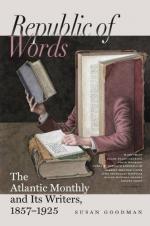It only remains for me to speak of my return to Rome in 1861, after an absence of twenty years, and of the favorable change and the enlargement during that time of Keats’s fame,—not as manifested by new editions of his works, or by the contests of publishers about him, or by the way in which most new works are illustrated with quotations from him, or by the fact that some favorite lines of his have passed into proverbs, but by the touching evidence of his silent grave. That grave, which I can remember as once the object of ridicule, has now become the poetic shrine of the world’s pilgrims who care and strive to live in the happy and imaginative region of poetry. The head-stone, having twice sunk, owing to its faulty foundation, has been twice renewed by loving strangers, and each time, as I am informed, these strangers were Americans. Here they do not strew flowers, as was the wont of olden times, but they pluck everything that is green and living on the grave of the poet. The Custode tells me, that, notwithstanding all his pains in sowing and planting, he cannot “meet the great consumption.” Latterly an English lady, alarmed at the rapid disappearance of the verdure on and around the grave, actually left an annual sum to renew it. When the Custode complained to me of the continued thefts, and asked what he was to do, I replied, “Sow and plant twice as much; extend the poet’s domain; for, as it was so scanty during his short life, surely it ought to be afforded to him twofold in his grave.”
Here on my return to Rome, all kinds of happy associations with the poet surround me, but none so touching as my recent meeting with his sister. I had known her in her childhood, during my first acquaintance with Keats, but had never seen her since. I knew of her marriage to a distinguished Spanish patriot, Senor Llanos, and of her permanent residence in Spain; but it was reserved for me to have the felicity of thus accidentally meeting her, like a new-found sister, in Rome. This city has an additional sacredness for both of us as the closing scene of her illustrious brother’s life, and I am held by her and her charming family in loving regard as the last faithful friend of the poet. That I may indulge the pleasures of memory and unite them with the sympathy of present incidents, I am now engaged on a picture of the poet’s grave, and am treating it with all the picturesque advantages which the antique locality gives me, as well as the elevated associations which this poetic shrine inspires. The classic story of Endymion being the subject of Keats’s principal poem, I have introduced a young Roman shepherd sleeping against the head-stone with his flock about him, whilst the moon from behind the pyramid illuminates his figure and serves to realize the poet’s favorite theme in the presence of his grave. This interesting incident is not fanciful, but is what I actually saw on an autumn evening at Monte Tertanio the year following the poet’s death.




